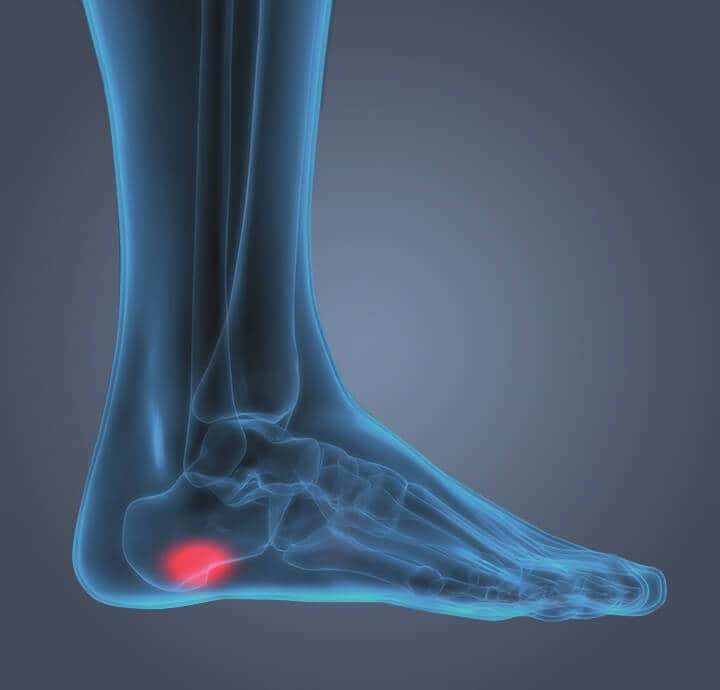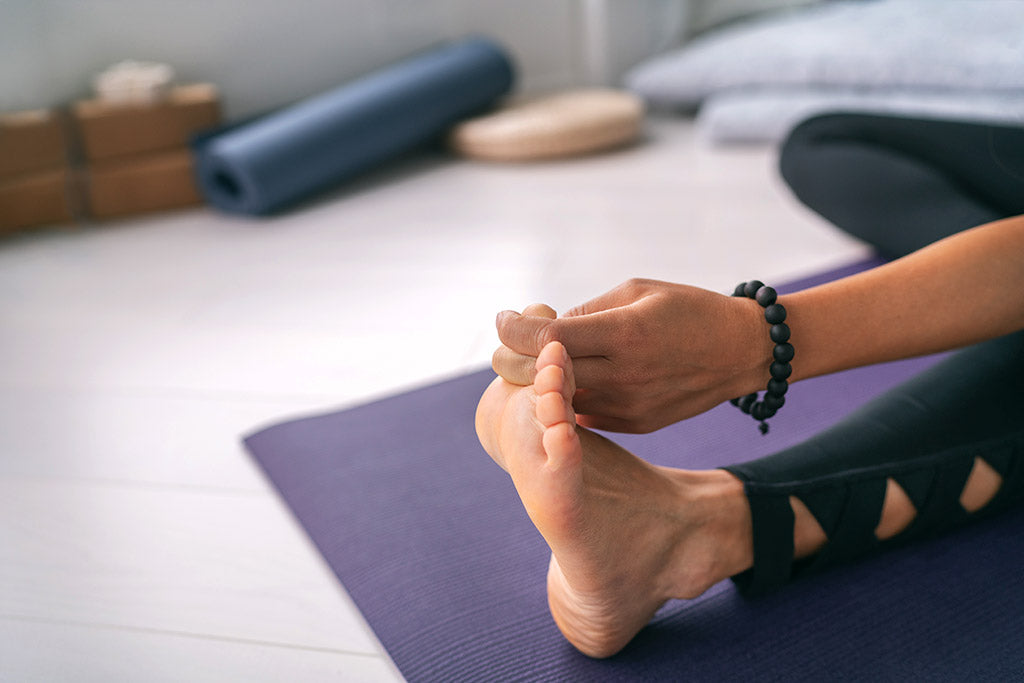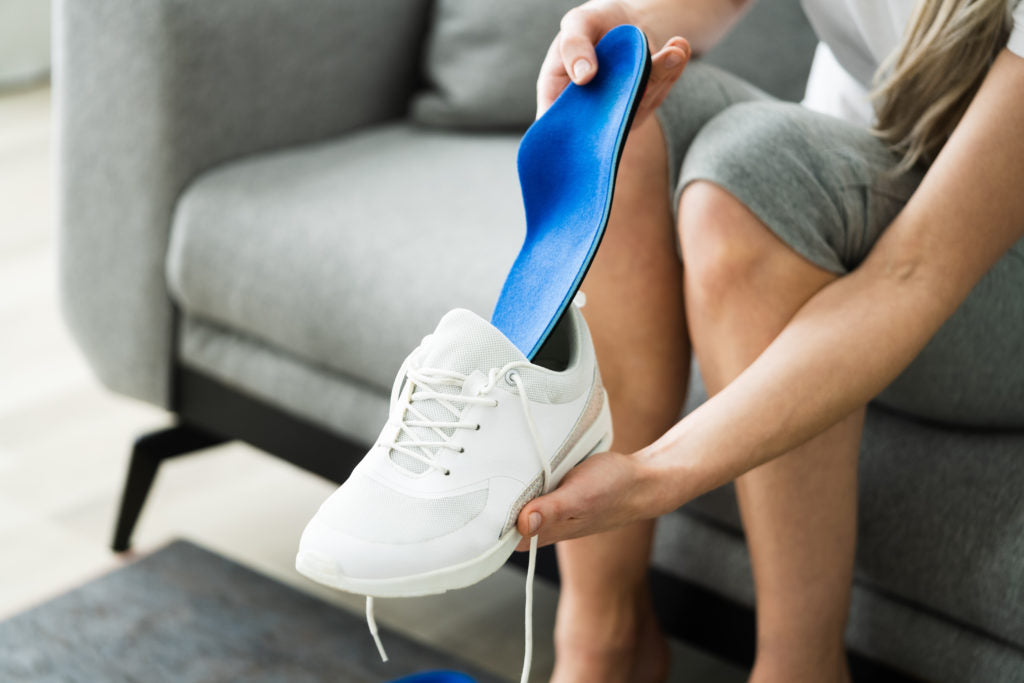
Plantar fasciitis is one of the most common causes of heel pain, and it can be a very painful condition. It is caused by inflammation in the tissue that connects the base of your toes to your heel bone, called the plantar fascia ligament. This tissue helps support the bones of your arch and absorbs some of the strain you put on your feet, whether from running or other kinds of vigorous exercise.
Typically, the main plantar fasciitis symptom is a stabbing pain around the heel of your foot, where the plantar fascia attaches to the heel bone. The pain can be intense after long periods of inactivity, such as when getting out of bed in the morning or getting up from a stationary position. The pain often lessens when walking, but may be persistent.
If you think you might have plantar fasciitis, you should contact your doctor. The sooner a doctor diagnoses and treats your problem, the earlier you will have pain relief.
Plantar fasciitis falls into a category of injuries referred to as overuse Injuries. The risk of plantar fasciitis increases with physical activity, especially when the activity occurs suddenly. The risk also greatly increases when there’s movement over hard and uneven terrain. A number of factors can contribute to the development of plantar fasciitis, including:
Physical activity – Athletic activities that exert force and pressure on the foot can lead to plantar fasciitis. The condition is most commonly associated with high-impact sports that involve running and jumping.
Improper footwear – Wearing the wrong type of shoe during physical activity can contribute to plantar fasciitis. Improper shoes lack good arch support and cushioning. This can leave the feet vulnerable and unprotected against forceful impact.
Excess body weight – When someone is carrying too much weight, the feet are forced to absorb additional shock. This can play a role in the development of plantar fasciitis.
Overpronation – When the natural movement of pronation is exaggerated during walking and running, the plantar fascia can become overstretched, possibly leading to pain and inflammation.
Abnormal foot structure – Arches that are high or flat can alter body alignment, potentially putting additional stress on the plantar fascia.
Hard surfaces – Standing, walking or running on hard surfaces can increase the risk of plantar fasciitis.

HOW TO HELP PREVENT PAIN FROM PLANTAR FASCIITIS?
• Wearing supportive shoes: Choose shoes that absorb shock, with good arch support and low heel.
Worn-out athletic shoes will no longer provide the cushioning and support you need, so make sure to get new shoes as needed.
• Avoiding going barefoot: This can put additional stress on your plantar fascia.
• Reducing the impact on your feet: By maintaining a healthy weight and practicing low-impact sports (such as swimming or bicycling), you can limit the stress on your plantar fascia. Heel pads in shoes can also help to lessen the impact and absorb shock.
• Doing arch stretches:
- Calf stretches and stretches using a towel: Place the towel under the ball of your feet, and pull gently the towel toward you, and hold a few seconds. Do this several times a day, especially when first getting up in the morning. Stretching the Achilles tendon at the back of the heel is especially important before sports, but it is helpful for non-athletes as well.
- Wall lunges: First step into a lunge stance, with one leg bent, toes facing forward and the other leg extended straight behind, with foot planted firmly on ground. Feet should be hip-distance apart. Place your hands on the wall in front of you, leaning into the stretch. The arch of your foot and your heel cord should stretch as you lean. Hold for 10 seconds and then relax and release out of the stretch. Repeat 20 times for each sore heel.
HOW TO RELIEVE PLANTAR FASCIITIS PAIN?
Having plantar fasciitis is a painful experience that may even require surgery, so it’s important to talk with your doctor about your symptoms. He or she can help make sure you don’t have another condition and help you learn how to get the plantar fasciitis pain management plan you need.
Treatments to manage plantar fasciitis pain can include:
• Taking a break from activities that cause the pain
• Using ice: Icing your heels for 15-20 minutes, 3-4 times a day, or after activity. This can help to reduce pain and inflammation.
• Using over-the-counter pain relievers as needed.
• Your doctor may also recommend physical therapy, padding, taping and strapping, using plantar fasciitis night splints or wearing a removable walking cast or boot, depending on your case.
• In addition, you may want to talk to your doctor about using Dr. Scholl’s Pain Relief Orthotics for Plantar Fasciitis, designed for added arch support and all-day relief of plantar fasciitis pain.
What does plantar fasciitis feel like?
The hallmark of Plantar fasciitis is pain a sharp pain in the heel that occurs with the first few steps taken in the morning. The pain may decrease over the course of the day during more active times but then return when standing up after sitting for an extended period.
How to treat plantar fasciitis
There are several different methods for treating plantar fasciitis. If you have pain that is severe or prolonged, ask your doctor for an evaluation and recommendations on what to do for plantar fasciitis.
The first steps in treating plantar fasciitis usually involve conservative methods including:
• Ice – Regular icing can help ease pain and decrease inflammation. Place an ice pack under the foot for up to 20 minutes at a time. Be sure to cover the ice pack with a cloth in order to avoid injuring the skin. This can be done several times a day.
• Over-the-counter NSAIDs – Non-steroidal anti-inflammatory drugs such as ibuprofen (Advil and Motrin) and Naproxen (Aleve) can be taken with approval from your healthcare provider in order to help with pain and inflammation.
• Insoles and orthotics – In addition to choosing good shoes with arch support and cushioning, insoles and orthotics can be helpful for reducing shock and improving foot alignment.
• Stretching and strengthening exercises – There are a variety of stretching and strengthening exercises that can help alleviate discomfort, especially when getting out of bed in the morning and after sitting for prolonged periods of time. A physical therapist can help put together a recommended routine for you.
• Night splints – Your healthcare provider may recommend a night splint in order to help reduce pain associated with standing right after getting out of bed in the morning. Night splints hold the foot in a slightly flexed position, gently stretching the plantar fascia.
When the pain from plantar fasciitis doesn’t respond to conventional treatments, a doctor may recommend other options including:
• Prescription medications – Over-the-counter pain killers and anti-inflammatory medications may not be enough for more severe cases of plantar fasciitis. When this is the case, a doctor may recommend prescription-strength pain killers and anti-inflammatory drugs
• Cortisone shots – A doctor may recommend cortisone injections in order to reduce inflammation and ease pain.
• Surgery – For cases of persistent and severe plantar fasciitis that don’t respond to more conventional treatments, surgery may be recommended.
How to heal plantar fasciitis
In order to heal plantar fasciitis, it’s critical to rest and avoid any movement that causes pain whenever possible. If the plantar fasciitis was caused by a specific activity, it’s important to stop that activity for a period of time in order to give the injury a chance to heal. This is often considered the best way to heal plantar fasciitis quickly, although the full healing process can take a considerable amount of time. In addition to rest, there are several ways to address inflammation and pain during healing, including:
• Ice – Cold therapy can be effective for pain and swelling from plantar fasciitis. Apply an ice pack to the bottom of the foot for up to 20 minutes several times throughout the day. It’s best to cover the ice pack with a cloth to protect the skin.
• Over-the-counter NSAIDs – Medications known as non-steroidal anti-inflammatory drugs such as naproxen and ibuprofen can help reduce inflammation as well as pain.
• Stretching exercises – Exercises designed to stretch and strengthen the plantar fascia are often effective for reducing pain and improving mobility. They can be particularly helpful first thing in the morning before getting out of bed.
• Shoes with good arch support and cushioning – Good shoes can help ease pressure on the foot. Insoles and orthotics can also help reduce pain from plantar fasciitis.
If these methods aren’t effective and the plantar fasciitis persists, a doctor can recommend stronger treatments.
How to get rid of plantar fasciitis
It’s very difficult to get rid of plantar fasciitis completely. The condition can take months to over a year to fully resolve. The duration depends on the severity of the condition and treatment methods. The best treatment for plantar fasciitis will vary among individuals since what helps plantar fasciitis in one person might not be as effective for someone else. However, doctors typically recommend starting with conservative methods such as rest, ice, over-the-counter pain relievers and stretching exercises.
When these more conservative approaches fail to make improvements, a doctor may recommend more aggressive methods such as prescription pain relievers and anti-inflammatory drugs, cortisone injections and even surgery in extreme cases.
If you have plantar fasciitis, see a healthcare professional for an evaluation and a treatment plan.
How long does plantar fasciitis last?
Left untreated, Plantar fasciitis can last several months to a year or even longer. However, the pain from plantar fasciitis can improve significantly after only a few weeks with treatment, stretching exercises and good arch support from shoes, insoles and orthotics.
How to cure plantar fasciitis in one week
There is no way to cure plantar fasciitis in one week, as persons that experience Plantar fasciitis are at risk to develop Plantar fasciitis again. However, a solid treatment plan combined with rest can yield significant improvements in just weeks and with continued precautions, help to keep Plantar fasciitis from reoccurring. If left untreated, it can take months to a year or even longer to cure plantar fasciitis.
Where does plantar fasciitis hurt?
The pain from plantar fasciitis is usually felt on the bottom of the foot on or near the heel.
Does plantar fasciitis go away?
Yes, in some cases plantar fasciitis goes away with rest and treatment methods. Some more severe cases of plantar fasciitis require stronger and more aggressive treatments prescribed by a doctor.
How do you get plantar fasciitis?
Plantar fasciitis typically occurs when there is constant pressure and stretching of the plantar fascia, a band of connective tissue that connects the heel bone to the toes. Over time, the plantar fascia can develop microtears at the point of attachment to the heel causing the heel area to become inflamed. There are risk factors that can increase a person’s chances of developing plantar fasciitis. These include:
• Obesity – Excess weight can put pressure on the feet, making them more susceptible to plantar fasciitis.
• Flat or high arches – Flat and high arches can have a negative impact on alignment, making people more vulnerable to a number of foot issues, including plantar fasciitis.
• High impact sports – Sports that involve running and jumping can make people more susceptible to plantar fasciitis due to constant pressure and stretching of the plantar fascia.
• Standing on hard surfaces or for extended periods –Constant standing, especially barefoot and on hard surfaces, can put stress on the plantar fascia.
• Poor quality shoes – Wearing shoes that lack proper cushioning and arch support can leave the feet vulnerable to conditions such as plantar fasciitis.
How to tape foot for plantar fasciitis
In order to tape a foot to help plantar fasciitis, start with athletic tape that’s rigid but still has a little bit of stretch. Some people prefer using kinesiology tape. It may be helpful to ask a physical therapist for help since it can be challenging for someone who is not trained. Start with clean feet and follow these steps:
1) Wrap a strip of tape around the ball of the foot.
2) Wrap a strip of tape around the heel.
3) Connect the ends of the strip around the ball of the foot to the ends of the strip around the heel.
4) Wrap a strip of tape around the back of the heel, pulling the tape across the sole and attaching the ends to the ball of the foot on the opposite side, creating an X pattern over the bottom of the foot.
5) Repeat the previous steps two or three times in order to increase support.
6) Apply several strips of tape in a horizontal fashion across the sole of the foot, covering the tape applied in the previous steps.
Be sure to remove any tape before going to bed.
Additional Resources
• https://www.mayoclinic.org/diseases-conditions/plantar-fasciitis/symptoms-causes/syc-20354846
• https://www.webmd.com/fitness-exercise/what-can-i-do-plantar-fasciitis#1
• https://www.uofmhealth.org/health-library/hw114458
• https://www.healthline.com/health/plantar-fasciitis-taping#materials
• https://www.mayoclinic.org/diseases-conditions/flatfeet/symptoms-causes/syc-20372604


